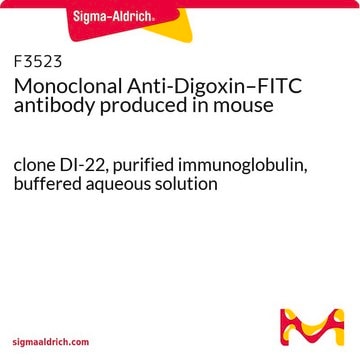11426320001
Roche
Anti-Fluorescein
from mouse IgG1 (clone B13-DE1)
Sinonimo/i:
antibody
Autenticatiper visualizzare i prezzi riservati alla tua organizzazione & contrattuali
About This Item
Codice UNSPSC:
12352200
Prodotti consigliati
Origine biologica
mouse
Coniugato
unconjugated
Forma dell’anticorpo
purified immunoglobulin
Tipo di anticorpo
primary antibodies
Clone
B13-DE1, monoclonal
Stato
lyophilized
Confezionamento
pkg of 100 μg
Produttore/marchio commerciale
Roche
Isotipo
IgG1
Temperatura di conservazione
2-8°C
Descrizione generale
Monoclonal antibody to fluorescein.
The detection of bound antibody can be carried out directly in one step using an anti-mouse Ig fluorochrome/enzyme conjugate, or in a two-step procedure with anti-mouse Ig fluorescein and, subsequently, anti-fluorescein enzyme conjugate.
The antibody does not contain any protein and can hence be used for coating and labeling.
Contents
Lyophilizate, stabilized
The detection of bound antibody can be carried out directly in one step using an anti-mouse Ig fluorochrome/enzyme conjugate, or in a two-step procedure with anti-mouse Ig fluorescein and, subsequently, anti-fluorescein enzyme conjugate.
The antibody does not contain any protein and can hence be used for coating and labeling.
Contents
Lyophilizate, stabilized
Specificità
The monoclonal antibody reacts with free and bound fluorescein.
Applicazioni
Use Anti-Fluorescein for the detection of fluorescein-labeled compounds using:
- ELISA
- Immunohistocytochemistry
- In situ hybridization
- Western blot
Nota sulla preparazione
Working concentration: Working concentration of conjugate depends on application and substrate. The following concentrations should be taken as a guideline:
Working solution: Phosphate buffered saline, pH 7.4
Using water instead the antibody can precipitate.
- ELISA: 2 to 4 μg/ml
- Immunohistocytochemistry: 0.5 to 2 μg/ml
- In situ hybridization: 0.2 to 0.4 μg/ml
- Western blot: 0.5 to 2 μg/ml
Working solution: Phosphate buffered saline, pH 7.4
Using water instead the antibody can precipitate.
Ricostituzione
Add 1 ml double-distilled water to a final concentration of 100 μg/ml.
Reconstitute for 15 minutes.
Reconstitute for 15 minutes.
Altre note
For life science research only. Not for use in diagnostic procedures.
Non trovi il prodotto giusto?
Prova il nostro Motore di ricerca dei prodotti.
Avvertenze
Warning
Indicazioni di pericolo
Consigli di prudenza
Classi di pericolo
Aquatic Chronic 3 - Skin Sens. 1
Codice della classe di stoccaggio
11 - Combustible Solids
Classe di pericolosità dell'acqua (WGK)
WGK 2
Punto d’infiammabilità (°F)
does not flash
Punto d’infiammabilità (°C)
does not flash
Scegli una delle versioni più recenti:
Possiedi già questo prodotto?
I documenti relativi ai prodotti acquistati recentemente sono disponibili nell’Archivio dei documenti.
I clienti hanno visto anche
Ignacio E Schor et al.
Current biology : CB, 28(22), 3547-3561 (2018-11-06)
Long non-coding RNAs (lncRNAs) can often function in the regulation of gene expression during development; however, their generality as essential regulators in developmental processes and organismal phenotypes remains unclear. Here, we performed a tailored investigation of lncRNA expression and function
J Spielmann et al.
BMC obesity, 4, 24-24 (2017-07-12)
Obesity was identified as a major risk factor for malignant diseases, but underlying mechanisms remain unclear. Natural killer (NK) cells, a pivotal aspect of innate immunity, are capable of identifying and killing virally infected and tumor cells. Previous studies have
Comparing nucleic acid lateral flow and electrochemical genosensing for the simultaneous detection of foodborne pathogens.
Aissa A B, et al.
Biosensors And Bioelectronics, 88, 265-272 (2017)
Yufeng Liu et al.
Oncology reports, 44(2), 499-508 (2020-07-07)
Apurinic/apyrimidinic endonuclease 1 (APE1) is a primary nuclear‑localized multifunctional protein in osteosarcoma. However, the cytoplasmic localization of APE1 was found to be functional and to increase with cisplatin resistance, yet the molecular mechanism is unknown. In the present study, we explored
María Fernanda Prado-Fernández et al.
Current issues in molecular biology, 46(7), 6885-6902 (2024-07-26)
Pereskia sacharosa Griseb. is a plant used in traditional herbal medicine to treat inflammation. We analyzed the phenolic content of P. sacharosa leaves (EEPs) by liquid chromatography-tandem mass spectrometry (LC-MS/MS) and investigated the anti-inflammatory properties of EEPs and its flavonoid
Il team dei nostri ricercatori vanta grande esperienza in tutte le aree della ricerca quali Life Science, scienza dei materiali, sintesi chimica, cromatografia, discipline analitiche, ecc..
Contatta l'Assistenza Tecnica.










